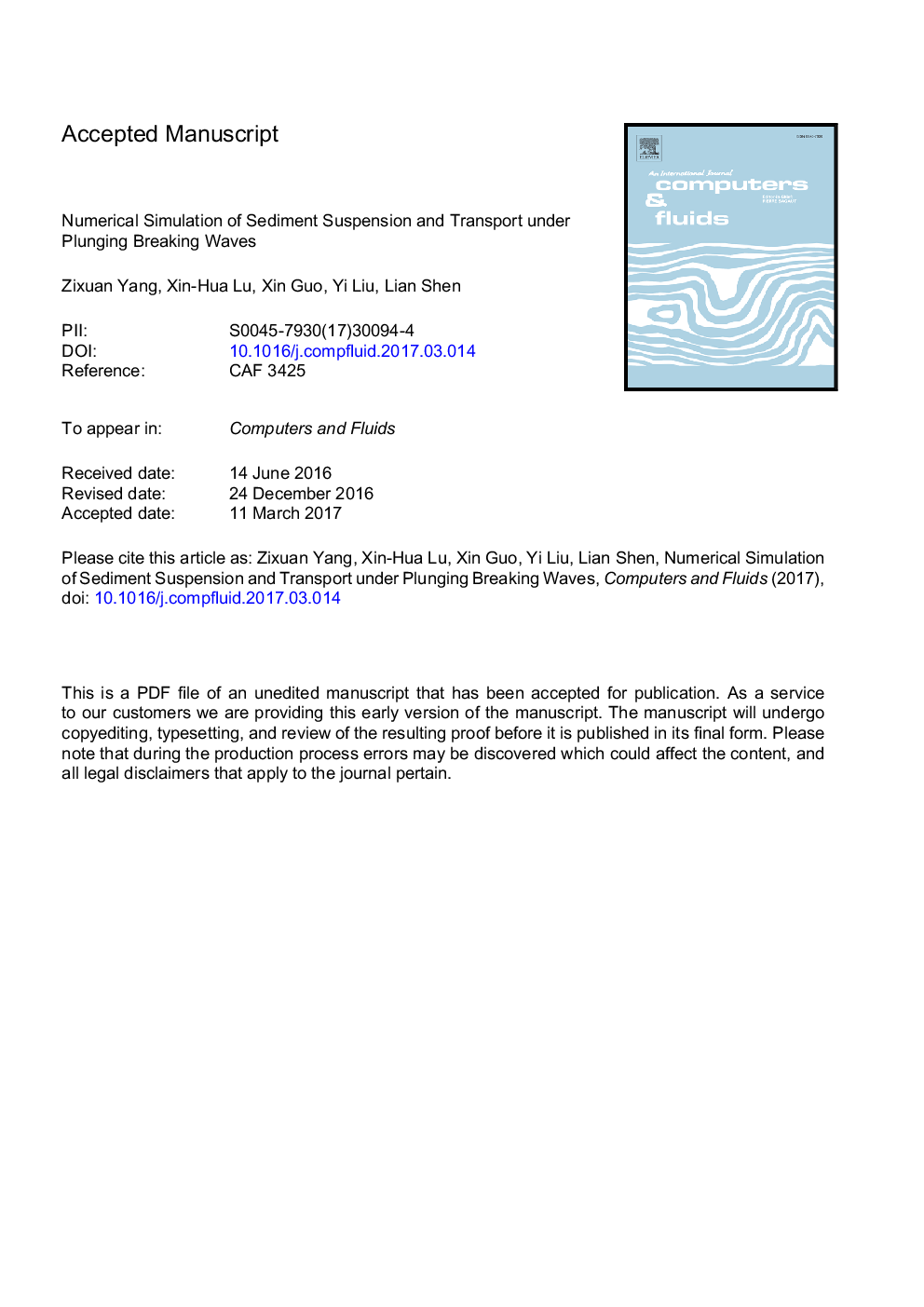| کد مقاله | کد نشریه | سال انتشار | مقاله انگلیسی | نسخه تمام متن |
|---|---|---|---|---|
| 7156574 | 1462653 | 2017 | 47 صفحه PDF | دانلود رایگان |
عنوان انگلیسی مقاله ISI
Numerical simulation of sediment suspension and transport under plunging breaking waves
ترجمه فارسی عنوان
شبیه سازی عددی تعلیق رسوب و حمل و نقل تحت امواج شکستن غوطه ور
دانلود مقاله + سفارش ترجمه
دانلود مقاله ISI انگلیسی
رایگان برای ایرانیان
کلمات کلیدی
حمل و نقل رسوب، شکستن امواج شکستن، شبیه سازی بزرگ،
ترجمه چکیده
ما یک مطالعه مبتنی بر شبیه سازی بر روی تعلیق و حمل رسوب تحت یک موج شکن را انجام می دهیم. معادلات ناییر استوکس برای جریان چند فاز غیر متراکم با استفاده از یک کد تقسیم محدود در خانه حل می شوند. رابط کاربری هوا و آب با استفاده از روش تنظیم سطح و حجم مایع همراه می شود. برای توصیف انتقال غلظت رسوب، معادله انتقال حرارت با اصطکاک برای یک اسکالر غیرفعال حل شده است. تابع برداشت برای رسیدگی به جریان رسوب در پایین استفاده می شود. پنج مورد با عمق آب و عمق موج مختلف شبیه سازی شده است. نتایج هر دو لحظه و آماری بر روی غلظت رسوب به منظور بررسی فرآیند تعلیق رسوب و حمل و نقل مورد تجزیه و تحلیل قرار گرفته است. از نتایج شبیه سازی مشاهده شده است که در طی شکست موج، رسوب به دلیل تنش برشی بالا در پایین آب معلق است. شکست موج موجب حرکت آب به بالا بین دو گرداب ضد چرخشی بزرگ می شود که به نوبه خود رسوب های معلق را به سمت سطح آب انتقال می دهد. بر اساس تجزیه و تحلیل مرکز توده رسوب معلق، فرایند انتقال رسوب تحت موج شکستن فرو ریختن به مرحله فرسایش، مرحله تعلیق و مرحله حمل و نقل تقسیم می شود. اثرات عمق آب و تونل موج بر میزان غلظت رسوبات معلق، فرسایش و فرسایش پایدار و مرکز رسوب رسوب مورد بحث قرار گرفته است. همانطور که عمق آب کاهش می یابد و در صورت افزایش تدریجی موج، رسوب بیشتر در طی شکست موج می شود. تغییر شکل بستر همچنین بر اساس معادله انتقال ارتفاع بستر پیش بینی شده است.
موضوعات مرتبط
مهندسی و علوم پایه
سایر رشته های مهندسی
مکانیک محاسباتی
چکیده انگلیسی
We perform a simulation-based study on the suspension and transport of sediment under a plunging wave breaker. Navier-Stokes equations for a multi-phase incompressible flow are solved using an in-house finite-difference code. The air-water interface is captured by using the coupled level-set and volume-of-fluid method. The convection-diffusion equation with a settling term for a passive scalar is solved to describe the transport of the sediment concentration. The pick-up function is used to address the sediment flux at the bottom. Five cases with different water depth and wave steepness have been simulated. Both instantaneous and statistical results on the sediment concentration are analyzed to investigate the processes of sediment suspension and transport. It is observed from the simulation results that during wave breaking, sediment is suspended due to the high shear stress at the water bottom. The wave breaking also induces an upward motion of water between two large scale counter-rotating vortices, which in turn transports the suspended sediment towards the water surface. Based on the analysis of the mass center of suspended sediment, the process of sediment transport under the plunging breaking wave is divided into the erosion stage, suspension stage, and transport stage. The effects of water depth and wave steepness on the bulk concentration of suspended sediment, bottom erosion and deposition fluxes, and the mass center of sediment are discussed. As the water depth decreases and as the wave steepness increases, more sediment is picked up during the wave breaking. The bed deformation is also predicted based on the transport equation of the bed elevation.
ناشر
Database: Elsevier - ScienceDirect (ساینس دایرکت)
Journal: Computers & Fluids - Volume 158, 24 November 2017, Pages 57-71
Journal: Computers & Fluids - Volume 158, 24 November 2017, Pages 57-71
نویسندگان
Zixuan Yang, Xin-Hua Lu, Xin Guo, Yi Liu, Lian Shen,
